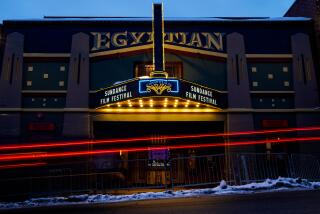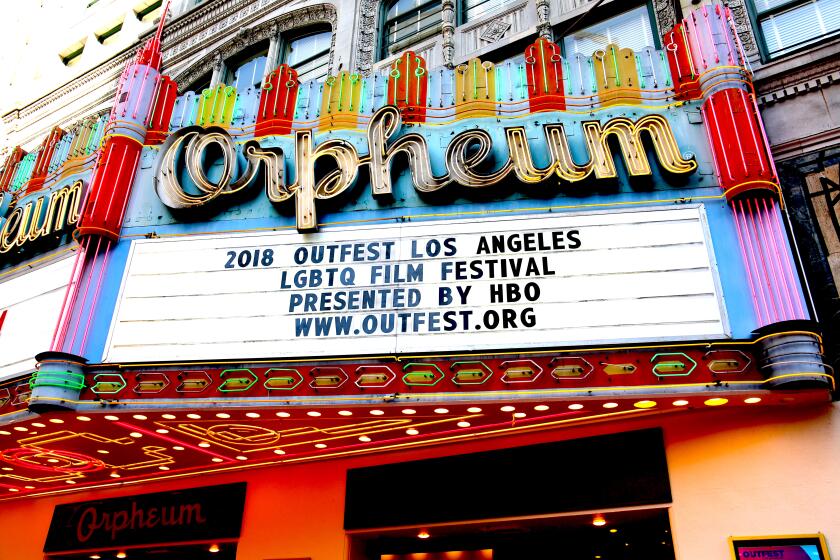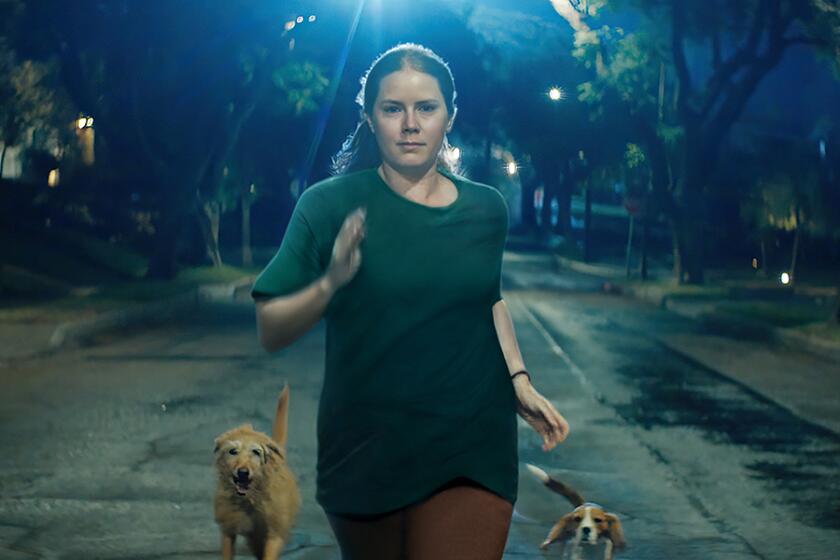Sundance buyers, beware! Studios may be more cautious after last year’s flops
- Share via
Generations of filmmakers have headed to the tiny resort town of Park City, Utah, for the Sundance Film Festival with dreams of landing big deals and launching their careers.
Maybe it’s the thin mountain air, but the festival has a long history of bidding wars that often end with distributors paying hefty sums for hot-ticket movies. While some become profitable hits and Oscar candidates, many struggle to make their money back at the box office.
The 2020 edition of the festival, which begins Thursday and runs through Feb. 2, may be less of a gold rush for dealmakers, after a number of pricey acquisitions faltered in the past year and many films are arriving at the festival with distribution already in place.
Fewer than 100 feature films are coming to Sundance seeking distribution, according to data compiled by industry sources. That’s down 14% from the 116 that came to the festival without a distributor in 2019. The total number of features being shown, 127, is down 12% from a year ago.
Paying top dollar for a hyped-up festival title raises a movie’s profile, to be sure. But on the flip slide, such high-stakes gambles not only raise the financial bar for a movie to turn a profit, but they also set unrealistic expectations in the public eye. Multiple studios have fallen victim to the cruel expectations game in recent years.
Last year, for example, saw a rash of high-profile deals from Amazon Studios, which was under the new leadership of studio head Jennifer Salke, looking to show it was still a serious player in the indie film business. Among five high-profile acquisitions, Amazon paid an estimated $14 million for “Brittany Runs a Marathon,” which grossed $7.2 million, and $13 million for U.S. rights to release “Late Night,” which topped out at $15.5 million domestically. Amazon executives have said that box office is not their only barometer for success and the Sundance acquisitions were successful on its streaming service.
Not to be outdone, Warner Bros.’ New Line Cinema paid $15 million for “Blinded by the Light,” a movie inspired by the music of Bruce Springsteen, which also bombed in theaters. Given the handful of high-profile failures, it’s not surprising that 2019 was the first year since 2012 that not a single film from any of Sundance’s official sections cleared $20 million at the domestic box office.
Tom Bernard, co-founder and co-president of Sony Pictures Classics, compared last year’s Sundance to past festivals where distributors made splashy deals either to make a statement to the industry or to fill a hole in their release slate.
In 1999, Harvey and Bob Weinstein’s Miramax notoriously won a protracted bidding war for “Happy, Texas,” paying what rivals said was more than $10 million (Miramax said it paid much less). The movie flopped at the box office and became Sundance shorthand for the kind of high-altitude, lightheaded decisions that buyers now studiously try to avoid.
“Every year, new people come on the scene to make a name for themselves and to show they have a bankroll,” Bernard said. “Last year felt like a ‘Happy, Texas’ year.”
This year, said Bernard, studios headed to Park City may be more cautious to avoid overpaying and setting themselves up for disappointment.
There’s good reason for caution. For every runaway success like “Little Miss Sunshine,” “Brooklyn,” “Manchester by the Sea” or “The Big Sick,” there are many more films that fail to connect with audiences. The feast-or-famine theatrical indie film market has become even more challenging in recent years as studio blockbusters take up more of the box office oxygen.
Searchlight Pictures, formerly Fox Searchlight and now owned by Disney, responded to the difficult market years ago by focusing on films it produces in-house. In 2016, the company paid a record-breaking $17.5 million for Nate Parker’s “The Birth of a Nation.” But a resurfaced rape allegation from Parker’s past — for which Parker was acquitted in a 2001 trial — derailed the studio’s release plans, and the movie flopped.
The following year, Searchlight shelled out a reported $9.5 million for the hip-hop crowd-pleaser “Patti Cakes” only to see the film come up short with a mere $800,000 in domestic box office. Searchlight hasn’t acquired a Sundance premiere feature since, but this year will bring two of its in-house productions to the festival: “Wendy,” the first film from director Benh Zeitlin since his 2012 breakout, “Beasts of the Southern Wild,” and the marital comedy “Downhill,” starring Will Ferrell and Julia Louis-Dreyfus.
“Most people are smart enough not to get burned twice,” Bernard added. “A lot of the buyers this time are more seasoned.”
Even as specialty film releases face uncertain futures at the box office, Sundance has largely remained an attractive place for distributors and agents to do business. Newer studios come in hopes of building their brands by dealing with up-and-coming filmmakers. Agents scour the festival for fresh talent to sign.
“Sundance sets the tone for the year ahead in terms of the talent you’re watching,” said Focus Features President Robert Walak. “That’s one of the most exciting things of the festival. It’s a good barometer for what’s going on in film culture.”
Last year, multiple companies bid for Lulu Wang’s “The Farewell,” which performed solidly for distributor A24. The highly personal film, with much of its dialogue in Mandarin, generated a tidy $19.6 million in global ticket sales after its July debut.
But increasingly, deals for movies are locked up outside the festival. Some distributors have noticed a less frantic pace of dealmaking in recent years, with many agreements closing after the festival ends. Alternatively, multiple deals are set ahead of Sundance as distributors and streamers try to acquire films while avoiding the frothy auction environment of the festival itself.
“I’ve gotten three or four calls from agents saying they’ve made a sale preemptively, sight-unseen, ahead of the festival,” said Kiska Higgs, who oversees acquisitions for Comcast Corp.-owned Focus Features.
The landscape of companies looking to make a splash with their checkbooks changes from year to year. Several years ago, it was Netflix’s turn to try to prove itself as a serious distributor of independent and mid-budget film. Now that Netflix’s strategy has evolved to focus on a robust internal production slate, the streamer has had to rely much less on acquisitions.
This year the company is using the festival to debut 10 finished films, its biggest number ever for Sundance. Netflix premieres include Dee Rees’ “The Last Thing He Wanted,” starring Anne Hathaway and Willem Dafoe, and “Taylor Swift: Miss Americana,” a documentary about the singer-songwriter.
For Rees, a Sundance veteran who broke out with “Pariah” at the festival’s 2011 edition, returning with a film already set for distribution relieves some pressure. Her 2017 period drama “Mudbound,” starring Mary J. Blige, Carey Mulligan, Jason Clarke and Jason Mitchell, was the biggest acquisition of the festival that year at a reported $12.5 million from Netflix. It received a limited theatrical release, though Netflix does not release box office grosses, and earned four Oscar nominations.
“The Last Thing He Wanted,” an adaptation of the 1996 novel by Joan Didion, finds Rees again working with Netflix, though it was not a given that she would return to the streaming service.
“I don’t take anything for granted. We definitely shopped the film around to other studios, and Netflix once again was the studio that raised their hands,” Rees said. “And with today’s thinking about what makes a hit, it’s refreshing to have a studio that is willing to take risks still, that’s willing to make a movie at the proper budget level and sees a film as a piece of art, not as an equation.”
Even with more of its own content to show, Netflix still acquired four films and one short out of last year’s festival — including the Oscar-nominated documentary “American Factory” — and many potential deals remain on the table for studios trekking to Sundance. Beverly Hills-based UTA is bringing 16 movies to Sundance, which Rena Ronson, co-head of the talent agency’s independent film group, said is the most in her over decade-long tenure.
“Studios are open for business when it makes sense,” Ronson said. “For every company that is doing more production in-house, you will have another emerging platform or studio that is more active. There is a balance.”
WarnerMedia’s HBO Max, for example, is expected to be an active buyer at the festival this year. The AT&T-owned streaming service is looking for new content to entice customers when it launches in May. And Apple TV+ will be on the hunt for content after scooping up the dramatic competition title “Hala” last year and severing ties with one of this year’s higher profile premieres when Oprah Winfrey stepped away as executive producer of the documentary “On the Record,” about sexual assault allegations against Russell Simmons.
But there’s no doubt that with Searchlight, Focus, A24, Netflix, Bleecker Street and even Disney+ all bringing their own product to the festival this year — and established documentary outlets including HBO, Hulu, National Geographic and Showtime filling similar slots in the non-fiction lineup — the number of filmmakers experiencing festival sales anxiety has diminished.
Eliza Hittman, whose films “It Felt Like Love” and “Beach Rats” were acquired at Sundance by Variance Films and Neon, respectively, returns this year with “Never Rarely Sometimes Always.” The story of a teenage girl in Pennsylvania who takes a trip to New York City to get an abortion has already been picked up by Focus Features and will be released in March.
Hittman said she considers Sundance the “perfect home for the film,” but acknowledged the peace of mind of having her distribution and release date already in place.
“I make mostly very low-budget movies. So you always feel that you’re outshined by a movie with a bigger sale or a bigger cast. There are movies at Sundance that are shiny,” Hittman said. “[This year] I get to go and enjoy the festival and hope that the energy around the movie is good — that it helps us build towards our release.”
Among the shinier objects at this year’s festival are a pair of titles already at home with A24: Janicza Bravo’s “Zola,” co-written with “Slave Play” playwright Jeremy O. Harris and starring Taylour Paige and Riley Keough, and Lee Isaac Chung’s “Minari,” an immigrant drama starring Steven Yeun.
Returning filmmakers looking to score distribution for their latest efforts include Sean Durkin (“Martha Marcy May Marlene”) with “The Nest,” starring Jude Law; Miranda July (“Me and You and Everyone We Know”) with “Kajillionaire,” starring Evan Rachel Wood and Gina Rodriguez; Josephine Decker (“Madeline’s Madeline”) with “Shirley,” starring Elisabeth Moss; and Justin Simien (“Dear White People”) with the retro horror-satire “Bad Hair.”
Filmmakers Nat Faxon and Jim Rash, who won an adapted screenplay Oscar for Searchlight’s “The Descendants” in 2012, saw their directing debut, “The Way Way Back,” make headlines with a splashy Sundance acquisition of more than $10 million when it was acquired by the studio in 2013.
They return this year with “Downhill,” based on the Swedish movie “Force Majeure,” scheduled to be the first release under the new post-Disney, Searchlight Pictures banner.
“Obviously, having [Searchlight] involved in ‘Downhill’ was also a big component of us wanting to join the film,” Rash said. “They are one of the few places out there making the kind of films that we gravitate towards. And there aren’t many places like that left.”
Faxon remembers the night of the premiere of “The Way Way Back,” when festival director John Cooper and then-director of programming Trevor Groth took pity on the two obviously anxiety-stricken filmmakers backstage and offered them each a shot of local High West whiskey to calm their nerves. That was only the start of a very long night, the kind that Sundance dreams are still made of.
“I remember that night being just full of happiness and relief,” Faxon said. “Jim and I were called to a meeting at about 2 in the morning to go hear some buyers’ pitch on why they should be the ones that we should be talking to and feeling like, ‘Wait, what now?’ ... I think we were pretty naive to the whole process, which kind of contributed to that sense of wonderment of it all.”
For Cooper, who is now in his final year as festival director before stepping into a new role as emeritus director, having so many anticipated films coming into the festival with distribution plans already in place is a sign of health for the independent film community.
“I think it’s good news, actually. I think it means ... there are companies that are finding ways of making those films sustainable in their systems,” Cooper said.
Cooper, who has held his post since 2009 and started with the Sundance Institute in 1989, said he has learned one thing from all the ebbs and flows in the independent film business over his many years at Sundance.
“What you have to do is just hold steady, keep your hand on that tiller and it will come back to you,” Cooper said of Sundance’s consistent mission. “Don’t listen to outside pressure ... put your head down, do the work and try to make the best program possible. Because showing bad films, it does nothing for you.”
More to Read
Only good movies
Get the Indie Focus newsletter, Mark Olsen's weekly guide to the world of cinema.
You may occasionally receive promotional content from the Los Angeles Times.













